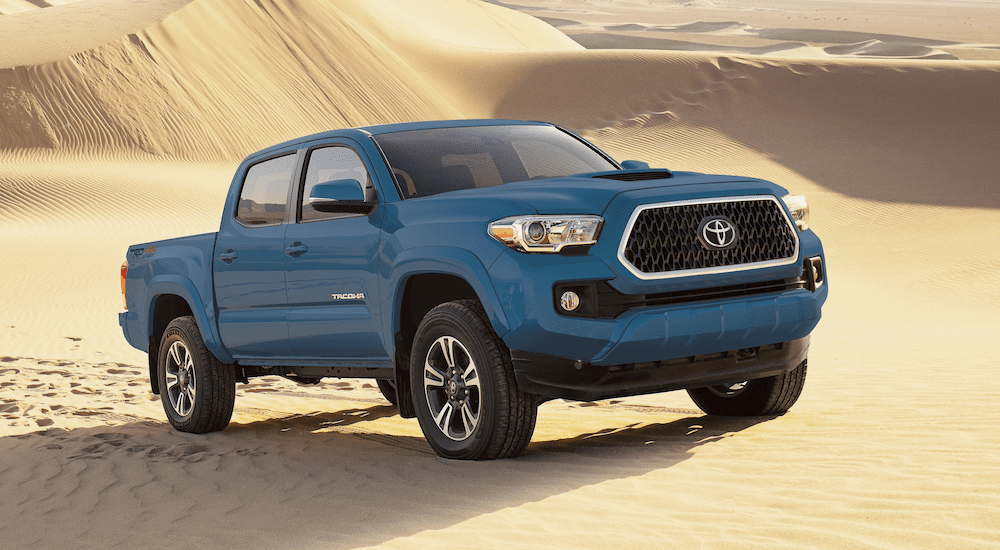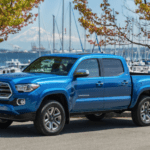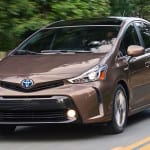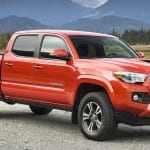Japanese auto giant Toyota is well known for their sedans, but in the U.S. Ford and Chevy often top the charts. Toyota looks to make waves in the status quo with the 2019 lineup of Toyota trucks. While they only offer two pickup trucks in the North American market: the Tacoma and the Tundra. Both are highly respected and highly sought after trucks. So, how exactly does a company best known for cars compete in a pickup truck market?
Especially here in the United States, Ford, Chevy, and GMC dominated the pickup truck market. Americans wanted homegrown engineering and technology in their pickup trucks. After all, the pickup is an American invention. Therefore, it took until the 1980s for Toyota to break into the American pickup market. They did so by first introducing the T100. It sounds like a villain from an Arnold Schwarzenegger movie, but the T100 was actually a compact pickup truck. The significantly larger Tundra would later replace it. The Tacoma, on the other hand, has had far better success. The Tacoma is one of the best-selling vehicles in the United States, having sales of nearly 200,000 vehicles in the last two calendar years.
Are these trucks able to stand up on the road in a more conventionally domestic market? From an engineering standpoint, absolutely. Toyota has a long and successful history of innovative automotive engineering. However, brand loyalty is very big in the automotive world, particularly so in the pickup truck market. That may all depend on your personal brand of loyalty.
2019 Toyota Trucks – The Toyota Tacoma
The Toyota Tacoma is classified as a mid-sized pickup truck, although in its first generation, debuting in the mid-1990s, it was considered a compact pickup truck. This design was intended less for recreational use and focused more on being an everyday vehicle. The handling and engine power lent themselves much better for a daily commute than off-road use. This was intentional, as that was about the time that pickup trucks became more popular for this type of daily use. While still utile as a pickup truck, it was clearly geared more towards being an everyday kind of vehicle.
This design, coupled with the Tacoma’s aesthetics, sold very well initially, particularly among younger generations of truck buyers. While still clearly a pickup truck, it had a less boxy look than traditional Fords or Chevys. It was a sleeker look, which made it a trendier option. When younger drivers are given an option between a new look and the truck their parents and grandparents drove, they are invariably going to pick the former.
The second generation Tacoma, unveiled in 2004, gave the Tacoma a boost under the hood. This truck had more power and performance and started to look more like a traditional American design. Toyota would also greatly expand the number of configurations available, from engine and transmission to cab size and bed lengths. This meant that drivers who were now comfortable and familiar with the Tacoma could get a new one but greatly customize it to suit their driving needs. Not a bad strategy there, Toyota.
The third generation, released in 2015, took the Tacoma in yet another direction. This look is much more rugged and hardy looking, with bold lines and a broader grill. Toyota also followed the industry trend of infusing more high-strength steel into the frame. By using this high-strength steel, you can both strengthen the frame and make it lighter overall. This steel is made in such a way that requires less of it on the frame, thereby reducing weight; however, it is much stronger than steel or aluminum used in the past, therefore making the frame considerably stronger. This generation also took the new ruggedness of the second generation up a notch by improving handling over certain terrains.
The 2019 Toyota Tacoma starts at $25,550 MSRP. It gets around 20 miles per gallon combined city/highway and is available in eight trim levels with 29 total configurations.
2019 Toyota Trucks – Toyota Tundra
The Toyota Tundra made its debut in 1999 for the 2000 model year. It was a replacement of the T100 and originally had many similarities to both the T100 and Tacoma. Despite not being as big as its Chevy or Ford counterparts, it was still honored by Motor Trend for “Truck of the Year” in 2000 and Consumer Reports for “Best Full-Size Truck.” Even then, it would take several more years for the Tundra to get a new, bigger body.
The second generation Tundra would change all that. Along with a bigger body came a bigger engine and higher tow capacity. The 2007 Tundra got a brand new 5.7-liter V8 engine that got 381 horsepower and 401 lb-ft of torque. This enabled the Tundra’s tow capacity to jump from a meager 7,100 pounds to 10,000. Now, this Tundra had the potential to compete with Detroit’s finest. Like the Tacoma, the second generation Tundra got a slew of new trim levels and configurations. Unlike the Tacoma, however, the Tundra was built more with utility in mind. Special features included an integrated tow hitch, Vehicle Stability Control, traction control, and tailgate assist. They even made the door handles larger so that workers wearing gloves could still easily open the doors to the truck. Little design additions like this endeared the Tundra to construction and manual laborers, whereas previous editions weren’t as friendly.
The third generation, revealed in 2014, looked pretty similar to the second generation, at least on the outside. Slight differences in the raised hood, headlights and taillights, and body composition were surely noticed by some. The main differences, however, came on the interior. Along with new seats and new upholstery, the dash got a facelift, featuring new designs in controls and gauges. The Tundra now also featured a touchscreen and a backup camera. The third generation left the engines alone, for the most part, only ramping up the power on the 4.0 literV6. Tundra drivers got the same performance and utility of the second generation with a vastly improved interior.
The 2019 Toyota Tundra comes in starting at $31,420 MSRP and features a 4.6 liter V8 that gets 310 horsepower. It has nine trim levels and 27 total configurations.
Is that All?
For the North American market, Toyota is content to stick with these two models, at least for now. They have done well in replacing the Toyota Hilux, the Toyota T100 and the Toyota Pickup, all bygone Toyota models of the 1990s and before. The Tacoma has a death grip on the mid-sized truck market, commanding approximately 45% of that market share. The Tundra, on the other hand, has a long, uphill battle against Ford, Chevy, Dodge, and GMC. The Tundra only garners 5% of that market. At least it is ahead of the Nissan Titan, though.
Trucks such as the Hilux are still sold in Asia and other parts of the world, but, with the success of the Tacoma and Tundra, it is very unlikely we will ever be seeing that vehicle in America again. Unless you watch Back to the Future…Yep, that’s a 1985 Toyota Hilux Marty McFly almost wrecked drag racing.
A lot of truck drivers want American engineering in their pickups. That’s understandable and completely fine. Detroit makes some of the best vehicles in the world, specifically pickup trucks. But, if you are not picky about the country of origin of your vehicles, both Toyota trucks are perfectly good automobiles and definitely worth a look.





